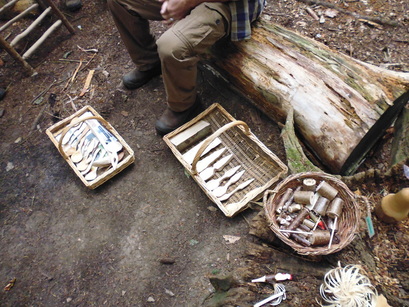
Walking through the forest, slowing down, acclimatising to the steady pace of its form, we realised a common experience of light, smell, sound and touch. Perhaps not a conversation in the literal sense but a conversation nevertheless that prompted a response in the form of questions- why was the trunk of the young beech trees wet, but dry with the older trees? ‘I like these trees they remind me of forests in North America……are there any Australian trees? ‘ - we were talking!
So onto another part of the conversation, spoon making- now you are talking! - very absorbing, moderately competitive – ‘start with a log, split it, split it again and once again to see the heartwood and the sapwood then go to work with your Swedish axe, knife and gouge’. Sitting on logs and working on another, the steady rhythm of carving which, on reflection, synchronised with the rhythm of the forest, led us into a closer conversation initiated by the grain of the timber, the imprint of the tools, the feel of the wood and the mistake which prompted a cry of anguish , sharing a new skill and more communication, a shared sense of achievement and expression – work with the grain and sing the spoon blues - ‘my spoon aint got no bowl and the handle lacks a crank’ - each spoon had a character, the conversation was evident and there was photographic proof.
So several questions arise – how should we define this conversation and would it have happened if we had not talked to the trees? We discussed what we had experienced, was it a selfish conversation, one of self- indulgence, or did it allow each of us to converse in our own way? Perhaps the language of the trees was more dominant than initially thought.
For me, lessons learnt include the expression of the encounter; that the conversation might be subtle and unconventional but it is happening and we need to be aware and open to the fact that it is happening, although not necessarily in a conventional way. That in sharing a common experience or activity, we establish a new dialogue, a new means of communication derived from the experience, a neutral, persistent, pervasive and all-embracing whisper from the forest in which we were immersed, inviting further enquiry, a common experience but individual conversations without any judgement from the trees that prompted them, a neutral environment available to us all. What might we need to move more deeply into conversation, what prior knowledge might help? If we had lingered longer or synchronised our minds in more forest centred activities, would the forest have shouted louder?
We left our ‘bio balls’ made of clay hanging from a tree to continue the conversation in our absence.
 RSS Feed
RSS Feed
